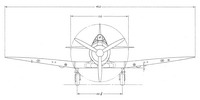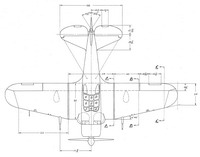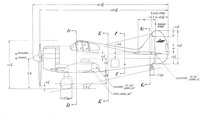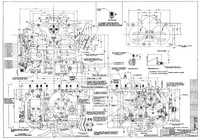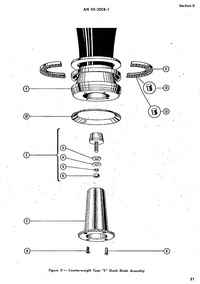
CAC Boomerang Technical Details
During the research for my drawings of the CAC Boomerang aircraft, I've collected a range of detailed technical information about this aircraft. On this page I have collected some of this technical information for viewing, as well as providing some links to additional websites or sources.
This page does not provide details about the history of the aircraft or the units which flew the Boomerang, since that is already covered well by other websites (see the list of links lower down the page).
If you have any comments or corrections or additions, feel free to send an e-mail to derek "at" buckmasterfamily "dot" id "dot" au
Also note that this information is only provided for historical interest, it should not be used in any way for the servicing or repair of aircraft.
Dimensions
The following drawings show the dimensions of the CAC Boomerang. These scans are taken from CAC drawing number AX-00002 which was drafted in 1956 at 1:24 scale (apparently for apprentices to make wooden models). The dimensions on the drawing are for the full-sized aircraft, and I've checked them against various CAC sources and other information for accuracy:
How long is a Boomerang?
There is some confusion regarding the length of the Boomerang, caused by different dimensions published in original CAC and RAAF documents. Here are the details of the length according to different sources:
- 25' 6" (approx) - according to the "Boomerang" Interceptor Overhaul and Repair Manual, RAAF Publication No. 256 issued in June 1943 by the Service Department of the Aircraft Division of Commonwealth Aircraft Corporation
- 25' 6" (approx) - according to the Manual of Operating Instructions for the "Boomerang" Interceptor Aircraft, RAAF Publication No. 257 issued in January 1943 by the Engineering Service Department, Commonwealth Aircraft Corporation
- 26' 5" - according to an RAAF station diagram published in a 1944 technical report by the Department of Techincal Services. The station diagram shows a length of 300" between the propeller plane and the TE of the rudder. Then allowing 17" in front of the propeller plane for the spinner, the total length comes to 317" (26' 5").
- 26' 9-27/32" - according to an undated CAC general arrangement drawing held by the Australian War Memorial. Click here to see a small version of this drawing.
- 26' 9-27/32" - according to a CAC factory drawing from 1956 (reproduced above)
- 25' 6" - according to a CAC datasheet published in the 1970's
So where does the truth lie? By analysing a number of sources and cross-checking the various drawings listed above, it appears to me that the actual length is 26' 9-27/32". This is based on my analysis of all the sources I could find, as well as correspondence with Richard Hourigan, an expert on Boomerang, Wirraway and Winjeel aircraft (Richard restored the first Wirraway to airworthy condition in the 1970's and is currently restoring his own Boomerang - which he was able to measure accurately). See my draft drawing of the Boomerang fuselage dimensions which brings all the different sources together and shows correct dimensions. This length is also used by Zbigniew Luranc (although he states it as 8,175 mm) in his highly accurate drawings of the Boomerang, which were based on information provided by Richard Hourigan.
Engine
Pratt & Whitney Twin Wasp R-1830 S3C4-G geared engine:
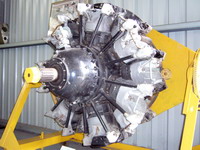
|
Detailed photos of the Pratt & Whitney R-1830 S3C4-G engine on display at the Australian National Aviation Museum in Moorabbin, Australia. Click the thumbnail at the left to view the photos on Flikr. |
Stromberg PD-12F2 carburettor:
Propeller
The Boomerang was fitted with a 11 foot diameter Hamilton Standard constant speed propeller. This comprised a 3E50 hub with 5105A-0 forged aluminium blades. The part numbers for these items provide the following descriptions:
3E50 hub description:
3 = 3 blades
E = Blade shank size "E"
50 = SAE #50 prop shaft spline size
Pitch range = 20°
High pitch setting = 45°
Low pitch setting = 20°
5105A-0 blade description:
5105 = basic blade design
A = the blade is an Assembly (including the blade itself, bearing assembly, chafing ring, bushing, bushing drive-pins, bushing drive-pin screws, and balancing-plug assembly)
-0 = the length of each blade is not reduced from the basic design.
Note that 6105-24 blades are noted in some references, but RAAF Technical Order PO44 (16 January 1943) states that these are "early experimental type blades".
Manuals
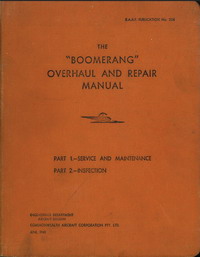 |
The Boomerang Overhaul and Repair Manual RAAF Publication No. 256 Issued by the Engineering Service Department of Commonwealth Aircraft Corporation Pty Ltd, January 1943 This manual covers all the information required for servicing and repairing the Boomerang aircraft. The manual is divided into 3 parts:
You can order an electronic copy in PDF format from Mach One Manuals. Note that their scanned version is missing Part III. |
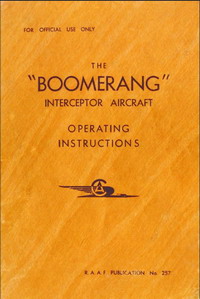 |
Manual of Operating Instructions for the "Boomerang" Interceptor Aircraft RAAF Publication No. 257 Issued by the Engineering Service Department of Commonwealth Aircraft Corporation Pty Ltd, January 1943 This manual covers all the information required for operating the Boomerang aircraft. This includes notes for pilots and descriptions of operating all the aircraft equipment and controls. You can sometimes find copies available on eBay, or order an electronic copy in PDF format from Mach One Manuals. |
Additional internet information sources
You can find more information regarding the Boomerang on these websites:
- Wikipedia entry for CAC Boomerang
- ADF Serials website entry for A46 Boomerang (this list includes the service history of all Boomerangs produced)
- RAAF Museum website entry for A46 series Boomerang
- Details of A46-30 held at the RAAF Museum at Point Cook
- Return To Flight website details the story of the restoration of A46-73 by Ben Morgan
- Details of A46-206 "Millingimbi Ghost" on display at the Museum of Australian Army Flying in Oakey, Queensland.
Bibliography
A selection of books, magazine articles and newspaper articles related to the Boomerang:
- Pentland, Geoffrey. Wirraway and Boomerang Markings. Dandenong VIC, Australia, Kookaburra Technical Publications, 1970
- Wilson, Stewart. Wirraway, Boomerang & CA-15 in Australian Service. Sydney, Aerospace, 1991. ISBN 0-958797-88-9
- Vella, Joe. From Fisherman's Bend - The Aircraft of the Commonwealth Aircraft Corporation, Air Enthusiast magazine, No. 61 January/February 1996
- Zbiegniewski, Andre R. and Nowicki, Jacek. CAC Boomerang & CAC Wirraway, Wydawnicto Militaria 43 (in Polish). Warszawa, Wydawnicto Militaria, 1997. ISBN 83-86209-57-7
- Classic Warbirds No. 7. Ventura Publications
